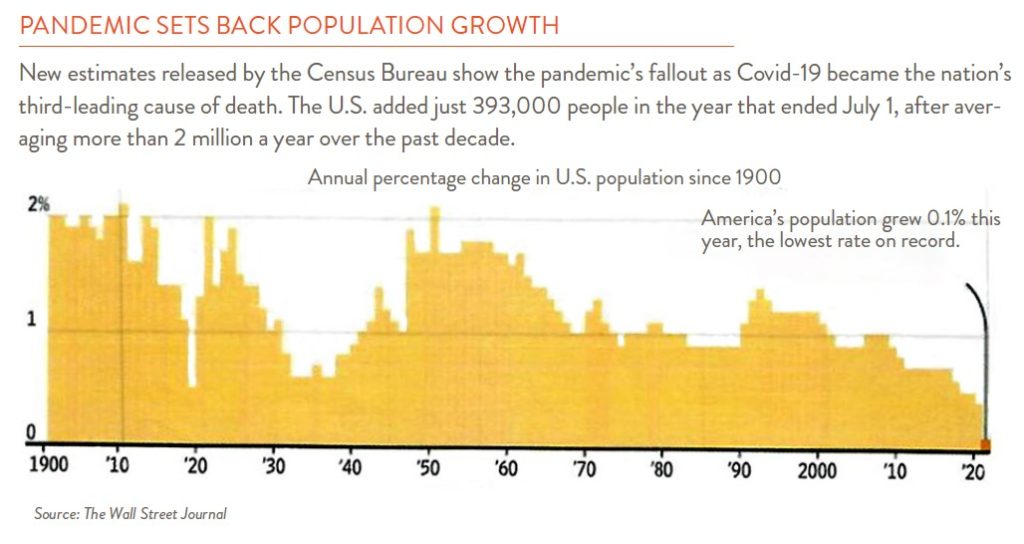The U.S. population grew 0.1% last year, the slowest rate on record. Births exceeded deaths by only 148k. This low number may be temporary, caused by the increase in Covid deaths and the delay in some births due to economic turmoil. But the fact is, the U.S. birth rate has been coming down. Between 1990 and 2010, the fertility rate, or the number of children a woman has over her lifetime, held steady at around 2.0. Since then, the rate has declined to 1.7.
This drop is greater than can be explained by the Covid crisis.

In addition to births and deaths, immigration also contributes to population growth. Last year, official immigration was 248k, which is down considerably from the past when immigration averaged500k to 1 million a year.
A slower growing population eventually leads to fewer workers and slower economic growth. To some this may not be bad. Slower growth means less pollution and fewer environmental calamities, but it can also lead to higher wage growth and inflation as businesses compete for
fewer workers.
The good news in all this, however, is that the U.S. is in less bad shape than many other parts of the world — or as they say, in the land of the blind, the one-eyed man is king. Even with a slowdown, the total U.S. population should continue to grow through 2050. Many countries
in Europe, including Germany, Portugal, Poland, and Russia, are experiencing declining population now, and China’s population should peak by 2030. Population growth isn’t everything but it is awfully important for the future standard of living and economic opportunity for the young.

Another factor which is important is a country’s attractiveness and receptiveness to immigrants. Fertility rates have imploded in Asia (see chart right). Japan used to be the poster child of low fertility, but now it is the leader of the pack in the region! Asian countries in general have not been that receptive to immigrants, and their economies are facing labor shortages now or will shortly. The region may have to resign itself to no population growth and pivot to policies like improving housing, water quality, and leisure activities for the existing population.
The U.S. has always been more accepting of immigration than other countries. We are a country of immigrants, and although there has always been friction between those who are here and those who are new, we have always adjusted. But right now, immigration is the “third rail” of national politics. You would think you could have a meeting of the minds between those who want to allow in more workers and those who want a more secure border, but you would be wrong. There is no compromise today.
We will have to keep working on this, however, because immigration is just too important. How about lifting visa caps for specific occupations, both lower-end and higher-end workers? And how about extending the period that foreign students can work in the U.S. after graduation? Colleges accept the best and the brightest from abroad and then we throw them out after graduation. We need immigrants. Let’s get to compromise.